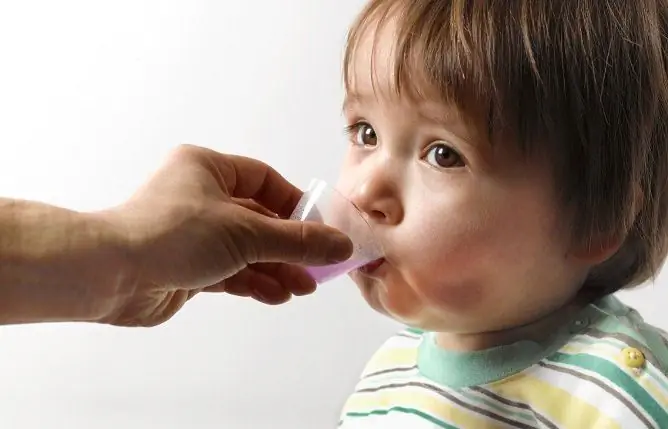- Author Rachel Wainwright [email protected].
- Public 2023-12-15 07:39.
- Last modified 2025-11-02 20:14.
How to cure a cough at home
The content of the article:
-
How to quickly cure a cough at home
- General recommendations
- Inhalation
- Folk remedies
- Compresses and rubbing
- Associated symptoms
- Causes and risk factors
- We treat cough in 1 day
- Video
How to cure a cough at home? The answer depends on the cause of the development of the pathology and a number of other factors. The cough reflex is the body's response to irritation of the mucous membranes of the respiratory tract, it can occur for physiological or pathological reasons.
Normally, a person has no more than 20 cough shocks per day. In the presence of a pathological process, the cough can be dry and wet (wet), depending on the absence or presence of sputum, as well as acute, prolonged and chronic, depending on the duration (up to 3 weeks, more than 3 weeks or more than 3 months a year, respectively).

In most cases, cough can be treated at home, but it cannot be done in 1 day.
If you suspect the development of a pathological process, you should contact a qualified specialist and undergo the prescribed examination. After the diagnosis is made, the doctor will prescribe treatment if necessary, which can be carried out at home under medical supervision.
The main therapy can be supplemented with traditional medicine, but it is not recommended to use them uncontrollably and / or as the only treatment.
How to quickly cure a cough at home
Treatment for different types of cough is different. So, with a dry cough, it is necessary to relieve irritation, moisturize and soften the mucous membranes of the respiratory tract, with a wet cough - to facilitate coughing up and excretion of sputum.
With a debilitating, unproductive cough, antitussive drugs may be prescribed to stop the cough reflex. They can be used in a very limited number of cases, only in the absence of sputum accumulations, they cannot be used together with mucolytics and expectorants, which are prescribed when necessary to dilute mucus and facilitate its removal from the respiratory tract.
Anti-inflammatory drugs are often used, for infectious diseases - anti-infectious drugs (antibiotics, antiviral drugs, etc.). In case of an allergic reaction, antihistamines are prescribed. For a psychosomatic cough, sedatives can be used.
For diseases of the gastrointestinal tract, the following can be used:
- drugs that improve intestinal motility;
- antisecretory drugs;
- antacids.
General recommendations
Patients are advised to drink plenty of water, with a tendency to edema (pregnancy, cardiovascular disease, kidney disease), the amount of fluid consumed is adjusted by the doctor. When coughing, you can drink tea with lemon, honey, milk-based products, berry and fruit juices, fruit drinks, compotes, warm mineral water.
If the patient's condition allows, he is recommended to walk in the fresh air. Patients are recommended a gentle diet (refusal of products that irritate the mucous membrane), quitting smoking and drinking alcoholic beverages.
Inhalation
The most effective methods of treating cough include inhalation, which can be done with an inhaler, nebulizer, or spray.
Steam inhalation is easy to do at home. The advantages of steam inhalation are ease of administration and affordability. In the absence of a steam inhaler, the patient can simply breathe steam over the container with the prepared solution, covering his head with a towel. The disadvantages of this method include the possibility of the patient getting burns of the mucous membranes and skin. It is inappropriate for children to carry out such inhalations.

Steam inhalation is the easiest method, but also the least effective
The advantages of inhalation with a nebulizer include their safety (it is impossible to get burned) and effectiveness: the particles of the drug are so small that they penetrate into the lower parts of the respiratory tract. In addition, when inhaling with a nebulizer, drugs can be used that lose their effectiveness when heated.
Preparations for the procedure, the concentration and frequency of inhalation are selected by the attending physician.
For inhalation, you can use:
- medicines;
- baking soda solution;
- saline or sodium chloride solution;
- mineral or sea water;
- essential oils;
- honey;
- infusions and decoctions of medicinal plants.
Contraindications include: individual intolerance to one or more components of the solution, a tendency to nose or pulmonary bleeding, arrhythmia, severe heart failure, pneumothorax. At elevated body temperature, steam inhalation is contraindicated, however, such patients can be treated with a nebulizer.
When carrying out inhalation, a number of rules should be followed:
- Start the procedure no earlier than 1-1.5 hours after eating or intense physical activity.
- Use only those solutions and in the concentration prescribed by the attending physician.
- Breathe through the mouth during the procedure, periodically breathing through the nose.
- Do not engage in any other activity during inhalation (including not talking).
- In the cold season, do not go outside for an hour after inhalation.
- For an hour after inhalation, do not eat, smoke, or speak loudly.
- Clean the nebulizer after each procedure according to the instructions for use.
- After inhalation, rinse your face with water and rinse your mouth to get rid of any drug residues.
- The temperature of the solution for steam inhalation should be 50-55 ° C.
The inhalation time is 5-10 minutes for adults; for children, the duration of the procedure depends on the patient's age and the active substance. So, the duration of the often prescribed inhalation with saline using a nebulizer for children is presented in the table.
Table. Duration of inhalation with saline, depending on the age of the child
| Age | Duration of the procedure |
| Up to 1 year | No more than 1 minute |
| 1-2 years | 1-2 minutes |
| 3-6 years old | 2-5 minutes |
| 7 years and older | 5-10 minutes |
Folk remedies
To alleviate cough and accelerate the regeneration of the mucous membrane of the respiratory tract, folk remedies are used. Their use requires consultation with a doctor.
Plant-based products:
- Buckwheat with a golden mustache. The daily use of infusion of buckwheat flowers and golden mustache leaves (10 g each) helps to soften and moisturize the mucous membranes of the respiratory tract. Pour the mixture of plants with 500 ml of boiling water and leave for about 40 minutes.
- Calamus roots. With coughing attacks and the absence of phlegm, the infusion of calamus roots helps well (1 tablespoon of dry raw materials per 1.5 cups of boiling water). The tool must be infused for 10 minutes, take 2/3 cup 30 minutes before meals. For coughing attacks at night, you can use 1 teaspoon of a mixture of honey and lemon juice (in equal parts).
- Garlic with honey. A mixture of minced garlic (2-3 cloves) and honey (2 tablespoons) may help. The drug is taken 1 teaspoon 2 times a day for 2 days, then you need to take a break for 1 day, if necessary, taking the drug can be continued in the same way.
- Raisins. You can use a decoction of raisins, for the preparation of which 100 g of raisins are poured into 1 liter of water, brought to a boil and cooked over low heat for 30 minutes. The mixture is allowed to cool, filtered and taken 0.5 cups 3 times a day.
Milk recipes:
- Milk with alkaline water. It is recommended to drink warm milk mixed with alkaline mineral water in a 1: 1 ratio. You can also drink milk with baking soda (0.5 teaspoon of baking soda per glass of milk).
- Warm milk with honey (1 teaspoon per glass of milk). You can add a little butter to the product. It is advisable to drink the drink before bedtime.
- Milk with anise. To prepare the product, 2 tablespoons of anise seeds are poured into 1.5 cups of milk, a pinch of salt is added, brought to a boil and removed from heat. Add 1 teaspoon of honey to the liquid and take 1 tablespoon every 3 hours throughout the day.
- Sage milk is good for dry coughs. To prepare the product, 1 tablespoon of dry herb is poured with 1 cup of boiling water and insisted for 25 minutes. Filter the liquid, add 1 glass of milk. The product can be sweetened with honey and consumed warm throughout the day.
- Milk with figs. 3-4 figs are poured with 1 glass of milk, the liquid is brought to a boil and cooked over low heat under a lid for about 2 hours. The drug is taken 50-100 ml before meals no more than 5 times a day. The figs should be eaten and the liquid drunk.

Milk with figs is a popular folk remedy for coughs
Black radish products:
- Squeeze juice from fresh radish, mix with honey in a 1: 1 ratio. The mixture is taken 3-4 times a day for 1 teaspoon (children) or 1 tablespoon (adults) spoon.
- Wash 1 radish, cut off the top and cut out some of the pulp. Honey is placed in the recess (you do not need to completely fill the radish with honey, you should leave room for the juice), the top is set in place, the radish is left for several hours. After the specified time, the mixture of radish juice and honey must be drained, a new portion of honey can be placed in the depression.
- Black radish (1-2 pieces) must be peeled, cut into cubes, placed in a suitable container, sprinkled with sugar and baked at medium temperature for about 2 hours. During cooking, care must be taken to ensure that the liquid does not evaporate and the radish does not burn. The resulting syrup is poured into a storage container, 2 teaspoons are consumed 3 times a day.
Compresses and rubbing
Cans, mustard plasters, compresses can be used as an additional warming agent for some diseases. Doctors warn against their thoughtless use, such procedures have contraindications and must be agreed with the doctor.
- Rubbing. The chest is rubbed with a mixture of vegetable oil (10 ml) and ammonia (5 ml). You can also rub with interior fat.
- Compress with vodka. Gauze (about 30 cm) is moistened with vodka or alcohol (about 50 ml), placed on the chest (on the bronchial area), covered with parchment. The compress can be fixed with a warm scarf or scarf. After setting the compress, the patient should be under a warm blanket for about 30 minutes. The procedure is carried out 1 time in 2 days.
- Warming compress. It can be prepared from honey (2 tablespoons), mustard powder, vegetable oil, flour and vodka (1 tablespoon each). From the resulting mixture, you need to form 1-2 cakes, wrap them in gauze and place them on the patient's chest and / or back. The compress can be fixed on the body with a bandage and left overnight. Compresses can be placed on the chest and back. In this case, pediatric patients should be put on a compress on the chest or back in one procedure. The location can be alternated every other day. Warming compresses are contraindicated at elevated temperatures.
Associated symptoms
Dry cough often occurs in the early stages of diseases of the respiratory tract, while a few days after the onset of the disease, it can turn into a wet one.
With various pathological processes, a cough may be accompanied by:
- an increase in body temperature;
- pain and / or sore throat;
- pain in the chest;
- runny nose;
- difficulty breathing;
- change of voice (up to its temporary loss);
- nausea and vomiting;
- pallor and / or cyanosis of the skin;
- weakness, fatigue, drowsiness, etc.
Sputum is different for different diseases. In diseases of viral etiology, the sputum is usually transparent and colorless, does not contain impurities. A small amount of transparent viscous sputum can also be noted in case of an allergic reaction, bronchial asthma. With a bacterial infection, the sputum may contain impurities of pus, be yellowish or greenish in color.
In the case of a fungal infection in mucous sputum, cloudy lumps of white or gray color may be detected. With tuberculosis, oncological diseases of the respiratory system, blood can be found in sputum.
Causes and risk factors
Most often, cough occurs in diseases of the respiratory system, which include acute respiratory viral infections, inflammatory processes in the upper and lower respiratory tract (pharyngitis, laryngitis, tracheitis, bronchitis, pneumonia), bronchial asthma, tuberculosis, and malignant neoplasms of the respiratory tract.

In most cases, the cough is of a cold nature.
This symptom can be observed in diseases of the cardiovascular system (congestive heart failure), gastrointestinal tract (gastroesophageal reflux disease), endocrine pathologies (thyroid disease), helminthic invasions, osteochondrosis.
In addition, the cause of the development of this clinical sign may be:
- allergic reaction;
- hypothermia of the body;
- inhalation of too dry and / or dusty air, chemicals;
- smoking (active and passive);
- ingestion of foreign bodies into the respiratory tract;
- stress;
- the use of certain medications (angiotensin-converting enzyme inhibitors).
Diseases in which cough occurs can have non-infectious and infectious etiology. The causative agents of infection can be viruses, bacteria, microscopic fungi. In some cases, the disease can be complicated by the addition of a secondary infection. Cough attacks can occur with childhood infections (measles, whooping cough).
We treat cough in 1 day
Unfortunately, it is impossible to cure a cough in 1 day. If such a promise is encountered, you can be absolutely sure that it is a deception. An exception is a strong cough caused by a foreign body entering the respiratory tract, but this cannot be treated at home.
Video
We offer for viewing a video on the topic of the article.

Anna Aksenova Medical journalist About the author
Education: 2004-2007 "First Kiev Medical College" specialty "Laboratory Diagnostics".
Found a mistake in the text? Select it and press Ctrl + Enter.






